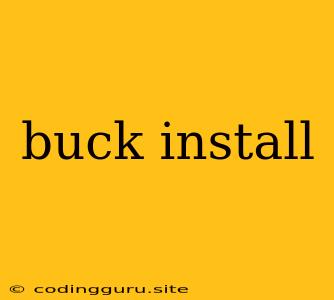What is buck install?
Buck install is a command within the Buck build system that takes your code and transforms it into a usable, installable application. Think of it like a master chef who takes raw ingredients (your code) and turns them into a delicious meal (your app) ready to be served (installed) on your device.
Why Should I Use buck install?
The buck install command offers several advantages over traditional build systems:
- Speed: Buck is known for its lightning-fast build times, especially on large projects. This is because it uses a parallel build process, which means it can build different parts of your application simultaneously.
- Flexibility: Buck allows you to build your app for different platforms (Android, iOS, etc.) and configurations (debug, release, etc.) with ease.
- Reliability: Buck ensures consistency in your build process, making it less likely to encounter unexpected issues or bugs.
How to Use buck install
The basic syntax of buck install is simple:
buck install
Here, <target> can be a specific target you've defined in your Buck build file, such as a library, an executable, or even an entire app.
For example:
buck install //my-app:app
This would install the "app" target within the "my-app" directory.
What Happens When You Use buck install?
Behind the scenes, the buck install command does a lot of work. It involves several steps:
- Compilation: It compiles your source code into machine-readable code (object files).
- Linking: It combines the object files and any necessary libraries to create a final executable or library file.
- Packaging: It packages the executable or library file into a format suitable for installation on your target platform (e.g., an APK for Android).
- Installation: It installs the packaged application onto your device or emulator.
Troubleshooting Tips
If you encounter errors while using buck install, here are some troubleshooting tips:
- Check your build file: Ensure your Buck build file is properly configured and that all the necessary targets and dependencies are defined.
- Clear your build cache: Sometimes a corrupted build cache can cause issues. Running
buck cleancan help. - Update your Buck version: Out-of-date Buck versions can lead to problems. Make sure you're using the latest version.
- Consult the documentation: The Buck documentation is a wealth of information and can help you troubleshoot common issues.
Key Benefits of Using buck install
Let's summarize the key benefits of using buck install for your development workflow:
- Faster Build Times: Reduces waiting time for your build process.
- Reliable and Consistent Builds: Minimizes the risk of unexpected build failures.
- Easy Platform and Configuration Management: Streamlines building for different targets and environments.
Conclusion
Buck install is a powerful command that streamlines the build process, making it easier and faster to create and install your applications. It helps developers focus on writing code rather than wrestling with complex build configurations.
By understanding the functionality and usage of buck install, you can significantly enhance your development experience and produce high-quality applications efficiently.
